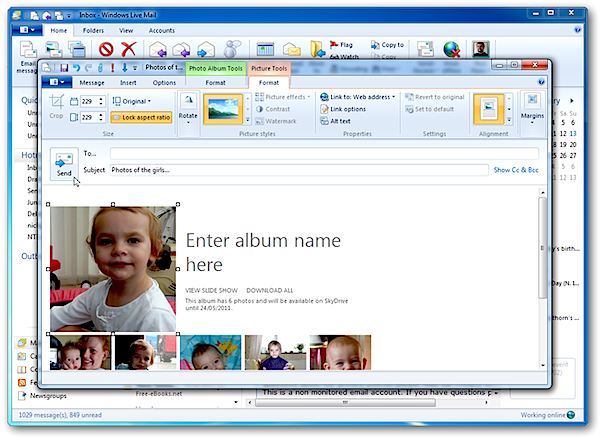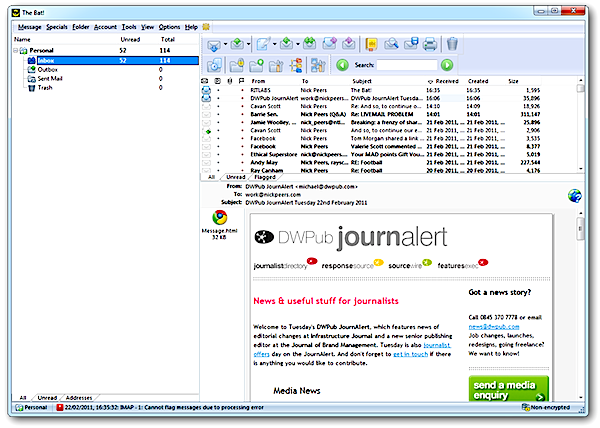By Nick Peers

Do you need an email client? These days, many people see the advantage of accessing their email through the web -- not only does this enable you to check it on any internet-enabled computer, it saves you having to open a separate program each time you want to check your email.
Having said that, you'll need to consider a dedicated email client if you want to access your email offline, or your web-based host's interface leaves something to be desired. You should also consider an upgrade if you're still using Windows Mail (Vista) or Outlook Express (Windows XP or earlier). In this roundup we've sourced five alternative email programs, some free, others not so, and put them through their paces to see which one is best suited for your needs.
Windows Live Mail
Windows Live Mail is the feature-rich successor to Windows Mail, but aside from the similar name, there's little in common between them. It ships as part of the Windows Live Essentials suite, but can be installed on its own.
Like all the clients featured here, it has an immediate edge over Outlook Express in that it supports web-based mail like Google and Hotmail (in fact, it's the best choice for Windows Live Hotmail users). The interface is clean and readable, and the spam filters work reasonably well. The downside is a lack of organizational tools such as labels or smart folders.
There are some added extras too: the photo email tool is a quick and effective way of sharing photos without clogging up someone's inbox, while the ability to read RSS feeds and newsgroups is welcome too. There's also a calendar component, but this suffers from a lack of integration with the email client.
Thunderbird
Looking for a cross-platform email client that won't cost you a penny? Thunderbird is the tool for you, working on Mac, Linux and Windows with no problems. It also offers the simplest way to transfer mail from PC to Mac, as we reveal here.
Thunderbird is also more powerful, if less exciting on the eye, than Windows Live Mail. There's an excellent spam filter, advanced filtering and search tools, plus the ability to create templates.
Getting around your mail is easy, thanks to back and forward buttons, message markers and tabs. And if you think the program lacks a crucial function, just open the Add-ons Manager to see if there's an extension that can add the tools you need.
If you were put off by the bugs and performance problems that plagued Thunderbird 3.0, now is the time to give the program a second try: version 3.1 doesn't just iron out these bugs and improve speed (particularly when searching your mail), it also adds useful new features like the Quick Filter tool, plus the ability to open multiple messages in their own tabs, making it easy to switch between them.
Microsoft Outlook 2010
Seeing how expensive Outlook is, it needs a pretty powerful feature set to justify the cost compared to free options like Thunderbird and Windows Live Mail. Outlook 2010 now sports Office's ribbon interface across the entire package, and introduces some useful new features for those with busy inboxes: you can organize, condense and even ignore messages with just a few clicks. Switch to Conversation view to further streamline your inbox.
Multiple accounts can now be combined in a single unified view, and Outlook's own built-in Calendar tool can now be viewed alongside Windows Live and other shared calendars, too.
One interesting feature is the Social Connector, which gives you access to more than just your contacts' email addresses; now you can also view their recent social networking history. It's all very powerful and much better organized than before thanks to Outlook's belated full embrace of the ribbon interface, but for the average user there's not enough here to justify the $140 asking price.
PostBox 2.0
Unlike most of the other clients on test, PostBox isn't free, but it's much cheaper than Outlook at just $29.95 -- and it's also cross-platform, so worth considering if you're looking to access your mail quickly and easily over both Mac and PC. It's based on the Mozilla platform, so will be familiar to Thunderbird users, but adds many exclusive features of its own, such as the Quick Reply option for firing off speedy responses without opening a new window, or the Summarised View, allowing you to review a message conversation without having to reread the whole piece.
Version 2.0 fixes many of the gripes people had with the original release: you can now unify multiple mailboxes to read all your email in one place. The Focus Pane allows you to filter your mail into specific categories to allow you to deal with mail based on its urgency. It all adds up to a powerful step up from Thunderbird without breaking the bank.
If you can live with a reduced feature set, check out its little brother, PostBox Express, which is completely free to use. Note PostBox Express is based on version 1.0 of the software.

The Bat!
If you're paranoid about security, then The Bat! is well worth checking out. Again, it's not free, but your $35 (Home) or $45 (Pro) outlay buys you an email client that uses its own HTML viewer to allow you to view emails as they were intended without having to worry about malicious code sneaking on to your PC. It also supports various encryption protocols to allow you to send and receive messages securely. Throw in some useful extras like the Smart Sorting Office for dealing with busy inboxes, and you've got an email client that ticks all the boxes for those who worry about email's inherent insecurities.
Conclusion
If your demands are basic -- or you're a Windows Live aficionado, then Windows Live Mail is a perfectly adequate and fuss-free tool to use. Thunderbird is our free option of choice, however, due to its versatility and superior feature set.
If you're happy to pay for a solution, then Outlook 2010 will appeal to professional users, but it's overkill for a simple email application, and it's easy to get confused trying to do even the simplest things.
Those who fear the safety of email should look more closely at The Bat!, with its emphasis on increasing security, but if a powerful feature set and cross-platform compatibility are key requirements, the best paid-for email client is without a doubt is PostBox. At the very least give it a whirl before settling for a freebie.
Copyright Betanews, Inc. 2010







